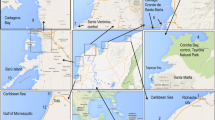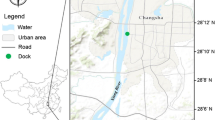Abstract
The concentrations of the metals cadmium, copper, mercury, lead, silver, selenium and zinc were measured in the muscle and gonad tissues of five species of fish, yellowfin bream (Acanthopagrus australis), silverbiddy (Gerres subfasciatus) and trumpeter whiting (Sillago maculata), southern log finned goby (Favonigobious lateralis), and the halfbridled goby (Arenigobius frenatus) from the contaminated Lake Macquarie NSW and three relatively uncontaminated reference estuaries, Wallis Lake, Port Stephens, and St. Georges Basin NSW. Fish from Lake Macquarie were found to have elevated concentrations of selenium, lead, cadmium, and zinc in one or both of these tissues in these species. Increased concentrations relative to background concentrations were most often observed at Cockle Bay, the site with the highest concentrations of these metals in sediments. The degree to which fish accumulated metals appeared to be related to life history characteristics of the species, with sediment-dwelling fish showing the greatest propensity to accumulate metals.







Similar content being viewed by others
References
Ankley GT, Di Toro DM, Hansen DJ, Berry WJ (1996) Technical basis and proposal for deriving sediment quality criteria for metals. Environ Toxicol Chem 15:2056–2066
Anon (1993) Water management and discharge at Pasminco Metals-Sulphide Pty Limited, Boolaroo Smelter. Asset Modernisation Programme Environmental Impact Statement Technical Report No. 5. Dames and Moore, 12 pp
Baines SB, Fisher NS, Stewart R (2002) Assimilation and retention of selenium and other trace elements from crustacean food by juvenile striped bass (Morone saxatilis). Limnol Oceanogr 47:646–655
Baldwin S, Deaker M, Maher W (1994) Low-volume microwave digestion of marine biological tissues for the measurement of trace metals. Analyst 119:1701–1704
Barwick M, Maher W (2003) Biotransference and biomagnification of selenium copper, cadmium, zinc, arsenic and lead in a temperate seagrass ecosystem from Lake Macquarie Estuary, NSW, Australia. Mar Environ Res 56:471–502
Batley G (1987) Heavy metal speciation in waters sediments and biota from Lake Macquarie, New South Wales. Aust J Mar Freshw Res 38:591–606
Biddinger GR, Gloss SP (1984) The importance of trophic transfer in the bioaccumulation of chemical contaminants in aquatic ecosystems. Residue Rev 91:103–145
Bolton JL, Stehr CM, Boyd DT, Burrows DG, Tkalin AV, Lishavskaya TS (2003) Organic and trace metal contaminants in sediments and English sole tissues from Vancouver Harbour, Canada. Mar Environ Res 57:19–36
Bury NR, Walker PA, Glover CN (2003) Nutritive metal uptake in teleost fish. J Exp Biol 206:11–23
Canli M, Atli G (2003) The relationships between heavy metal (Cd, Cr, Cu, Fe, Pb, Zn) levels and the size of six Mediterranean fish species. Environ Pollut:129–136
Chapman PM, Wang F, Janssen C, Persoone G, Allen HE (1998) Ecotoxicology of metals in aquatic sediments: binding and release, bioavailability, risk, assessment and remediation. Can J Fish Aquat Sci 55:2221–2243
Cook RD, Weisberg S (1999) Applied regression including graphics. Wiley, New York
Dallinger R, Prosi F, Segner H, Back H (1987) Contaminated food and uptake of heavy metals by fish: a review and proposal for further research. Oecol (Berlin) 73:91–98
Deaker M, Maher W (1995) Determination of selenium in selenocompounds and marine biological tissues using stabilised temperature platform furnace atomic absorption spectrometry. J Anal Atom Spectro 10:423–431
Digby PGN, Kempton RA (1987) Multivariate analysis of ecological communities. Chapman and Hall, London
Doyle CJ, Pablo F, Lim RP, Hyne RV (2003) Assessment of metal toxicity in sediment pre water from Lake Macquarie, Australia. Arch Environ Contam Toxicol 44:343–350
Engel DW, Brouwer M (1989) Metallothionein and metallothionein-like proteins: physiological importance. Adv Comp Environ Physiol 5:53–75
Fletcher G, King M (1978) Seasonal dynamics of Cu2+, Zn2+, Ca2+ and Mg2+ in gonads and liver of winter flounder (Pseudopleuronectes americanus): evidence for summer storage of Zn2+ for winter gonad development in females. Can J Zool 56:284–290
George SG (1982) Subcellular accumulation and detoxication of metals in aquatic animals. In: Physiological mechanisms of marine pollutant toxicity. Academic Press, New York, pp 3–32
Griscom SB, Fisher NS, Luoma SN (2002) Kinetic modelling of Ag, Cd and Co bioaccumulation in the clam Macoma balthica: quantifying dietary and dissolved sources. Mar Ecol Prog Ser 240:127–141
Gronlund WD, Chan S-L, McCain BB, Clark RC, Myers MS, Stein JE, Brown DW, Landahl JT, Krahn MM, Varanasi U (1991) Multidisciplinary assessment of pollution at three sites in Long Island Sound. Estuaries 14:299–305
Jarvinen AW, Ankley GT (1999) Linkage of effects to tissue residues: development of a comprehensive database for aquatic organisms exposed to inorganic and organic chemicals. SETAC Press. Pensacola, Florida, pp 1–358
Kingsford MJ, Gray CA (1996) Influence of pollutants and oceanography on abundance and deformities of wild fish larvae. Detecting ecological impacts: concepts and applications in coastal habitats. Academic Press, San Diego, California
Kirby J, Maher W, Harasti D (2001a) Changes in selenium, copper, cadmium, and zinc concentrations in mullet (Mugil cephalus) from the Southern Basin of Lake Macquarie, Australia, in response to alteration of coal-fired power station fly ash handling procedures. Arch Environ Contam Toxicol 41:171–181
Kirby J, Maher W, Krikowa F (2001b) Selenium, cadmium, copper and zinc concentrations in sediments and mullet (Mugil cephalus) from the Southern Basin of Lake Macquarie, NSW, Australia. Arch Environ Contam Toxicol 40:246–256
Lemly AD (1993) Teratogenic effects of selenium in natural populations of freshwater fish. Ecotoxicol Environ Saf 26:181–204
Lemly AD (1999) Selenium impacts on fish: an insidious time bomb. Hum Ecol Risk Assess 5:1139–1151
Maher W, Forstner S, Krikowa F, Snitch P, Chapple G, Craig P (2001) Measurement of trace metals and phosphorus in marine and animal plant tissues by low volume microwave digestion and ICPMS. J Anal Atom Spectro 22:361–369
Peters GM, Maher WA, Barford JP, Gomes VG (1997) Selenium associations in estuarine sediments: redox effects. Water Air Soil Poll 99:275–282
Peters GM, Maher WA, Krikowa F, Roach AC, Jeswani HK, Barford JP (1999) Selenium in sediments pore water and benthic infauna of Lake Macquarie New South Wales Australia. Mar Environ Res 27:491–508
Roach AC, Runcie J (1998) Levels of selected chlorinated hydrocarbons in edible fish tissues from polluted areas in the Georges/Cooks Rivers and Sydney Harbour, New South Wales, Australia. Mar Poll Bull 36:323–344
Roach AC (2005) Assessment of metals in sediments from Lake Macquarie, New South Wales, Australia, using normalisation models and sediment quality guidelines. Mar Environ Res 59:453–472
Roy PS, Crawford EA (1984) Heavy metals in a contaminated Australian estuary—dispersion and accumulation trend. Est Coast Shelf Sci 19:341–358
Scanes PR, Roach AC (1999) Determining natural `background’ concentrations of trace metals in oysters from New South Wales, Australia. Environ Pollut 105:437–446
Selck H, Forbes VE, Forbes TL (1998) Toxicity and toxicokinetics of cadmium in Capitella sp. I: relative importance of water and sediment as routes of cadmium uptake. Mar Ecol Prog Ser 164:167–178
Smith EP, Robinson T, Field LJ, Norton SB (2003) Predicting sediment toxicity using logistic regression: a concentration-addition approach. Environ Toxicol Chem 22:565–575
Sorenson E (1991) Metal poisoning in fish. CRC Press, Boca Raton, Florida
SPCC (1981) The ecology of fish in Botany Bay—biology of commercially and recreationally valuable species. Environmental control study of Botany Bay, report BBS23, Sydney, 78 pp
Syme W, Witt C, Morton R, Pocock M, McAlister A (1997) Lake Macquarie Estuary Management Plan. WBM Oceanics Australia
ter Braak CJF, P Smilauer (1998) CANOCO reference manual and user’s guide to Canoco for Windows: software for canonical community ordination (version 4.5). Microcomputer Power Ithaca, New York, 352 pp
Usero J, Izquierdo C, Morillo J, Gracia I (2003) Heavy metals in fish (Solea vulgaris, Anguilla anguilla and Liza aurata) from salt marshes on the southern Atlantic coast of Spain. Environ Int 29:949–956
Van den Brink PJ, Van den Brink NW, Ter Braak CJF (2003) Multivariate analysis of ecotoxicological data using ordination: demonstrations of utility on the basis of various examples. Australas J Ecotox 9:141–156
Van Derveer WD, Canton SP (1997) Selenium sediment toxicity thresholds and derivation of water quality criteria for freshwater biota of western streams. Environ Toxicol Chem 16:1260–1268
Viarengo A (1989) Heavy metals in marine invertebrates: mechanisms of regulation and toxicity at the cellular level. Crit Rev Aquat Sci 1:295–317
Villar C, Stripeikis J, Colautti D, D’huicque L, Tudino M, Bonetto C (2001) Metals contents in two fishes of different feeding behaviour in the Lower Paraná River and Río de la Plata Estuary. Hydrobiologia 457:225–233
Wang WX, Stupakoff I, Fisher NS (1999) Bioavailability of dissolved and sediment-bound metals to a marine deposit-feeding polychaete. Mar Ecol Prog Ser 178:281–293
Wang WX, Yan QL, Fan W, Xu Y (2002) Bioavailability of sedimentary metals from a contaminated bay. Mar Ecol Prog Ser 240:27–38
Weis JS, Smith G, Zhou T, Santiago-Bass C, Weis P (2001) Effects of contaminants on behaviour: biochemical mechanisms and ecological consequences. Bioscience 51:209–217
Willis TJ, Saunders JE, Blackwood DL, Archer JE (1999) First New Zealand record of the Australian bridled goby, Arenigobius bifrenatus (Pisces: Gobiidae). New Zeal J Mar Freshw Res 33:189–192
Zeitoun I, Ullrey D, Bergen W, Magee W (1976) Mineral metabolism during ontogenesis of rainbow trout (Salmo gairdneri). J Fish Res Board Can 33:2587–2591
Xu Y, Wang WX (2002) Exposure and potential food chain transfer factor of Cd, Se and Zn in marine fish Lutjanus argentimaculatus. Mar Ecol Prog Ser 238:173–186
Acknowledgments
We would like to acknowledge Tim Ingleton, Murray Root, and Samantha Welman for their assistance in the field. We also thank David Nicols, Peter Scanes, and Klaus Koop for helping facilitate this study. Alana Burt, Amina Price, and Katarina Mikac are thanked for their assistance with the fish dissection and digestion.
Author information
Authors and Affiliations
Corresponding author
Rights and permissions
About this article
Cite this article
Roach, A.C., Maher, W. & Krikowa, F. Assessment of Metals in Fish from Lake Macquarie, New South Wales, Australia. Arch Environ Contam Toxicol 54, 292–308 (2008). https://doi.org/10.1007/s00244-007-9027-z
Received:
Accepted:
Published:
Issue Date:
DOI: https://doi.org/10.1007/s00244-007-9027-z




